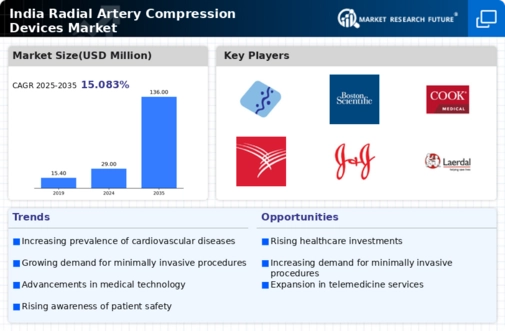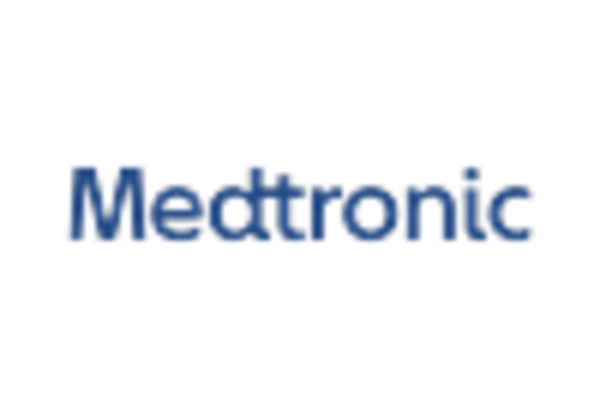Government Initiatives and Funding
Government initiatives aimed at improving healthcare infrastructure in India are a crucial driver for the radial artery-compression-devices market. The Indian government has launched various programs to enhance access to quality healthcare, which includes funding for advanced medical technologies. In 2025, the government is expected to allocate substantial resources to upgrade healthcare facilities, particularly in rural areas. This investment is likely to increase the availability of radial artery-compression devices in hospitals and clinics, thereby expanding the market. Additionally, public-private partnerships are fostering innovation and accessibility, which may further stimulate growth in the radial artery-compression-devices market.
Increasing Cardiovascular Procedures
The rise in cardiovascular procedures in India is a pivotal driver for the radial artery-compression-devices market. As healthcare facilities expand their capabilities, the demand for effective and safe arterial access methods increases. In 2025, it is estimated that cardiovascular diseases will account for approximately 30% of all deaths in India, necessitating advanced medical interventions. This trend indicates a growing need for radial artery-compression devices, which enhance patient safety and recovery times. Furthermore, the Indian healthcare sector is projected to reach $372 B by 2022, reflecting a robust investment in medical technologies. Consequently, the radial artery-compression-devices market is likely to experience significant growth as hospitals and clinics adopt these devices to improve procedural outcomes.
Rising Incidence of Lifestyle Diseases
The increasing prevalence of lifestyle diseases in India, such as diabetes and hypertension, is driving the demand for the radial artery-compression-devices market. These conditions often lead to cardiovascular complications, necessitating more frequent diagnostic and interventional procedures. Reports suggest that by 2025, nearly 75 million people in India will be living with diabetes, which correlates with a higher incidence of heart-related issues. As healthcare providers seek to manage these conditions effectively, the adoption of radial artery-compression devices becomes essential. The market is expected to grow as these devices facilitate safer and more efficient access to the arterial system, thereby improving patient outcomes and reducing recovery times.
Technological Innovations in Medical Devices
Technological advancements in medical devices are significantly influencing the radial artery-compression-devices market. Innovations such as improved materials, enhanced design, and integration with digital health technologies are making these devices more effective and user-friendly. For instance, the introduction of devices that provide real-time feedback during procedures is likely to enhance their adoption among healthcare professionals. The Indian medical device market is projected to grow at a CAGR of 15% from 2020 to 2025, indicating a strong trend towards modernization. As hospitals and clinics invest in cutting-edge technologies, the demand for advanced radial artery-compression devices is expected to rise, thereby propelling market growth.
Growing Focus on Minimally Invasive Procedures
The increasing emphasis on minimally invasive procedures in India is driving the radial artery-compression-devices market. These procedures are associated with reduced recovery times, lower risk of complications, and improved patient satisfaction. As healthcare providers aim to enhance patient care, the adoption of radial artery-compression devices becomes more prevalent. The market is projected to grow as more hospitals incorporate these devices into their standard practices. In 2025, it is anticipated that minimally invasive techniques will account for over 50% of all cardiovascular procedures in India, highlighting the potential for radial artery-compression devices to play a critical role in this evolving landscape.

















Leave a Comment